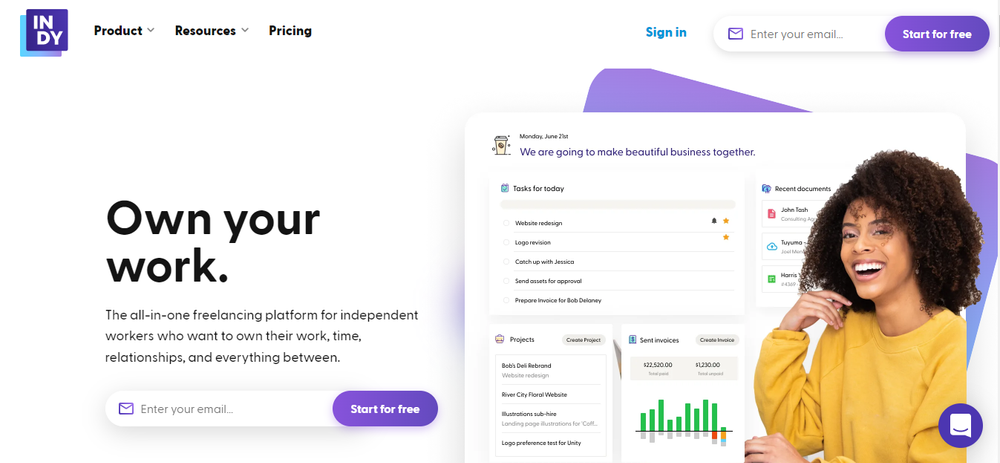Freelancing as an illustrator can be a rewarding career, with opportunities for flexible working hours and locations. It also means you have to be your own boss, manage your own deadlines, produce work to tight specifications, and find new clients on a regular case-by-case basis. It’s not easy. But the rewards are worth it.
As a freelance illustrator, you’ll need to be able to sell yourself as much as your portfolio. It can be challenging at first to find job opportunities, and landing your first clients can feel like a catch-22. However, if you have the right strategy, a strong portfolio, and are willing to put in the hard work, it can be a very fulfilling career path. And the best part is that there is always a demand for skilled illustrators.
We will guide you in becoming a freelance illustrator. Learn about the different things you should consider before taking this leap, what kind of training you need, or where you should look for jobs. Finding your niche as an illustrator will help you stand out from other artists, and we also have some useful tips on how to perfect your skills and build up your clientele.
What is a freelance illustrator?
A freelance illustrator is an artist who takes on private commissions and sells their artwork to clients. Freelance illustrators are in a very competitive field, especially when it comes to landing their first client. To make your chances of success much higher, you’ll need to have a solid plan for how you want to sell yourself and your work. Keep on reading to learn more.
Why become a freelance illustrator?
There are many reasons why becoming a freelance illustrator is appealing. Freelancing allows you to work from your home, which means you can spend more time with your family and less time commuting. It also gives you the flexibility to take on projects that interest you and turn down jobs if they don’t align with your skills or interests.
Freelance work also has more opportunities for creative freedom as an illustrator. There are no strict guidelines for what needs to be produced, which gives you the opportunity to have more input on what will be created and how it will be created. You can work with a variety of creative directors and different clients (as you choose potential clients), each of whom may have different styles and needs.
You can even customize your illustration style depending on the client, which will give you the chance to explore a variety of styles while still using your strengths. Being a freelancer also means that there are many opportunities to build brand identity or make good relationships with other artists.
You can even get new design projects on the way, like being commissioned by art galleries or working as an illustrator for video games in development stages.

What is the difference between illustration and graphic design?
In the past, drawings were done by hand, using pencils or paint. Some artists still use this method today, although many have shifted to utilizing computer-based graphic design tools like Adobe Illustrator.
What is the difference between illustrators and graphic designers, then?
Illustrators and designers utilize a lot of the same tools for their visual art, but this doesn't mean that they're interchangeable when it comes to their roles and what organizations hire them for.
Here's how a graphic designer is different from an illustrator:
The illustration is more of an art form than a design element. It is an image that tells a narrative and provides a visual picture of the subject matter. Despite the fact that both graphic designers and artists study the same fundamentals of color and balance at art school, the goals of each profession differ.
Brand logos, website design, magazine layouts, and product packaging are just some of the tasks that a graphic designer may work on. It's not the same as a talented artist who draws pictures to help others grasp or visualize a concept.
Responsibilities of a freelance illustrator
Freelance illustrators are professionals who have a knack for illustrating. They might not work at a company, and instead, they have their freelance business with their own hours. Freelancers create illustrations that represent clients’ products or services in a way that the clients find useful for marketing purposes.
Freelance illustrators might also be hired to illustrate a book cover, for example, children's books, comic books, or graphic novels. Freelance illustrators also must have strong drawing skills and experience in various types of illustration styles like cartooning, illustration, or comic book art.
One of the most important responsibilities of an illustrator is to communicate with clients as often as necessary to get information about the final product or service they are representing.
This means communicating with clients in a professional manner so that deadlines can be met. It also means being flexible when changes need to be made and finding ways to meet your clients’ needs within the existing budget.
1. Designing characters and creating concepts
Toys, fashion design, entertainment art, and other product design often go hand-in-hand with this. Companies use illustrators to develop concept art and character design for a variety of reasons. Toy businesses, greeting card companies, entertainment companies, and more all use freelancers to bring their concepts to reality.
2. Entertainment art
Entertainment art includes comic books, film and television matte paintings, and any other product for entertainment purposes.
Comic book artists, for example, can contribute to the success of their own publications by creating guest strips, panels, or cover art.
Like the art itself, illustration in art has a wide range of subcategories under which it may be classified.
3. Textile, apparel, and product design
Clothing and accessory prints, as well as T-shirt designs, would fall under this category. Companies, corporations, and other entities frequently outsource the design of clothing and other products even if they may have an in-house design staff.
In most cases, the freelancer will work with the internal design team via email, meeting deadlines and coordinating efforts rather than participating in internal meetings or dealing with higher-ups in the organization.
Other clothing-related designs could include hats, mittens, pins, or even more articles of clothing.
4. Editorial illustration and illustrations for books
Editorial illustration can be done for newspapers, periodicals, or blogs and is one of the most typical markets mentioned when discussing illustration work.
Large journals such as The New Yorker are known for their editorial illustrations, which are created by freelancers, rather than using stock imagery.
Book covers and inside artwork are the same way.
While graphic designers perform the designing, illustrators are frequently hired for their skills in drawing, painting, and their general artistic ability.
5. Packaging illustration
Unlike packaging design, custom illustration is part of the job of a graphic designer (either in-house or contracted).
Toys, cosmetic goods, food packaging, and other items all have the potential to be outsourced, depending on the design team involved.
Some corporations go so far as to create artist-specific product lines in an effort to capitalize on the fame of a well-known or rising illustrator.

How to land your first client?
It can be challenging at first to find job opportunities, and landing your first clients can feel like a catch-22. Finding your niche as an illustrator will help you stand out from other artists, but how do you find the right clients?
When looking for jobs, it's important that you target places where you know there is a need for your services. For example, if someone needs an artist to illustrate their children’s book and they're not sure who might be interested, they should research publishing companies in their area. They could also look up magazines in the same subject matter area and contact their art directors directly.
If a magazine doesn't have the budget to hire freelancers, they may recommend other publications or illustrators they know who are open to hiring more people.
Another way to find clients is by networking with people in the industry who may need freelance artists or illustrators themselves.
You can attend events like conventions and conferences related to your profession or join groups related to your profession on social media like LinkedIn or Facebook groups. You never know who might be looking for an illustrator!
What is the typical freelance illustrator salary?
In the United States, freelance illustrators may expect to earn anything from $37,000 to $70,000 each year, depending on their skills and previous work. It's possible to earn more money as a Freelance Illustrator depending on location and area of expertise, but there are fewer prospects for growth based on skill level.
What skills do you need to begin freelancing as an illustrator?
There are many skills needed for freelance illustration. You will need to have the ability to create a variety of different illustrations that suit your client’s needs. This includes sketches, paintings, children’s books, and any other assignments you may be given.
You need to have excellent drawing skills, or at the very least some basic drawing skills. You will also need to have an eye for what sells. You should constantly assess your work and see what you are capable of in order to provide your clients with the best services for their needs.
You will need to be able to deal with criticism, too. It can be hard knowing how someone feels about your work when they give you their opinion, even if it’s negative. People's opinions don't always match up with one another because art is so subjective, and people perceive it differently, so try not to get discouraged by criticism as it can help make you a better artist in the long run!

Do you need a college degree?
A college degree is not a requirement for being a freelance illustrator. In fact, many schools offer degrees in design and art, but that doesn't mean you need one to become an illustrator. You can even be self-taught and have a successful freelance career in illustration, but that does require a certain amount of talent as a prerequisite.
But if you're looking for some formal training, there are online courses and online schools where you can learn about illustration and how to make freelance illustration your career.
The best way for you to know what kind of training will suit you is by figuring out what type of work you want to do. If you want to do children's book illustrations, then an illustration program at a school would be beneficial. However, if you want to work in advertising or digital illustrations, then an art program might offer more opportunities.
Additionally, if you have the chance to get an internship at a design studio or advertising agency, jump on it! You’ll learn valuable skills that will help you become an illustrator for various industries and reach your goals faster.
What is self-employment and how does it work?
Each country has its own unique laws and regulations regarding having a freelance business (and state, province, prefecture, territory, etc.). There are a few things that never change, though.
- All income must be taxed
- Learn about your deductibles (supplies, research, tax credits, etc.)
- Before starting a small business, check out the costs, permits, and paperwork involved
- If you don't have the skills, you'll have to pay an accountant
As a self-employed aspiring illustrator, it's crucial to know your legal rights for your design services. That is also beneficial in knowing how to handle a stolen piece of work, as well as how to deal with contracts.
Freelance illustrators have illustration careers that are different from working for a company. In illustration work, most clients take ownership of whatever work you do, and that is fairly normal in the illustrator community.
So it's critical to understand if you may show off freelancing work on your online portfolio (did you sign a non-disclosure agreement?) or whether you can sell prints of the artwork (did you retain copyright and just license the artwork to the client?)
3 Quick tips for setting your rates
Don't charge hourly
The first thing to keep in mind is that you're not the only one who has difficulty negotiating pricing. This is because you can't just price work by how much time you spend on it. It all boils down to what the business plans to do with it next.
Pricing artwork is challenging because it's not just about service – it's about the possibility for businesses to use your work time and, again, to earn a profit. This is why use terms matter and why broad commercial use has a considerably higher value than limited work use.
There are so many variables to consider when it comes to pricing, which is why it may be so difficult. However, the more your work is seen or replicated, the greater the rate should be. An artwork that will only be displayed once will cost somewhere between $250 and $400. However, for multiple uses, the price range could be anywhere from $1,500 to $4,000.
There are no defined prices for any of this; the idea is to be consistent and to charge based on consumption rather than on the amount of time.
Estimate the cost of adjustments
Make sure the customer (and you) know exactly what they're receiving when you quote. For example, this does not always entail reworking a graphic until the customer is satisfied. However, if you don't explicitly state this, people may misunderstand.
As part of the contract, always define the amount of modifications that may be made and include a termination charge. Always add usage rights to your contract, and bump the price up an additional 10% to be able to negotiate.
See how much other illustrators charge
Checking what other illustrators are charging might give you further peace of mind that your pricing is on the money. Some illustrators will charge extra thanks to their expertise, quality of work, and the "name" they have established for themselves. However, you'll have an excellent idea of where to set your own rates.
How can Indy help?
As a freelancer, Indy helps you run your business. Send ideas, sign contracts, manage billable hours, produce invoices, and be paid all in one spot.

With Indy, you don't have to worry about arranging tasks. No one likes to waste time hunting for information they already have in their system, so that's why our system makes it easy to link customer and project information to your work. As a result, Indy's project dashboard provides you with real-time status information at a glance, so all you need to do is take a quick look, and there it is.
Conclusion
If you're looking for a flexible way to earn a living, being a freelance illustrator may be the perfect career for you. Just as a freelancer in any other field, you'll need to cultivate and maintain your skills, stay on top of trends and industry news, and learn how to market yourself.
But the rewards of being your own boss, working from home, and setting your own hours could be worth it. So what are you waiting for? Get illustrating and start your career today!



